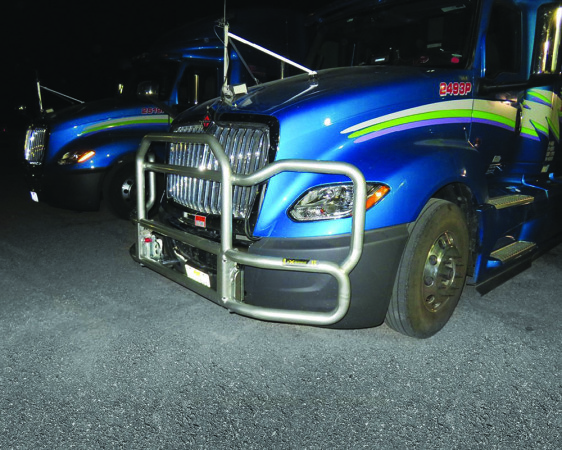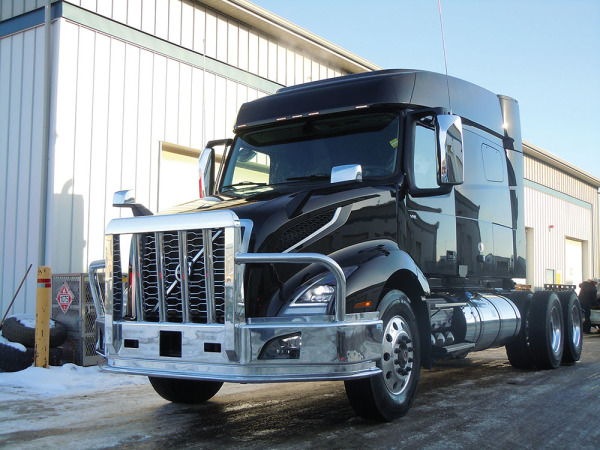Protecting your asset

Truck design engineers go to great lengths to perfect how air flows over the front of their vehicles and to painstakingly take every pound possible out of the vehicle. Only to see many customers attach a heavy moose bumper to the front end, the moment they take delivery.
But front-end protection devices (aka deer guards or moose bumpers) are as popular as they’ve ever been, maybe even more so. Trucks are becoming costlier to repair and downtime is a trucker’s worst enemy, which means some additional front-end protection is an acceptable trade-off for some compromise in payload or fuel economy.
“An average collision can be in the $5,000 to $10,000 range,” said Mike Eng, sales and marketing manager for Magnum Equipment in Abbotsford, B.C.
“If you are talking about a significant strike at highway speed, you can be talking upwards of $30,000 to $50,000 for a replacement hood, replacement air-to-air, replacement rad, fenders, lights and any structural damage to the frame.”
And while the insurance deductible will sting, the downtime associated with the repairs will be even costlier, especially for an owner- operator.
“For a collision like that, the truck could be at the repair facility anywhere from a couple weeks to a couple months or so,” Eng said.
Nathan Holt, marketing manager with Ex-Guard, agreed repairs are becoming more expensive.
“A simple thing such as a headlight that used to cost $200, now costs $700 to $800 (to replace),” he said. He’s seen simple crashes such as being backed into in a parking lot incur $15,000 in damages.
Stats and anecdotal information from the insurance industry supports claims of rising repair costs. Bill Moretti, director of business development with insurance broker Tredd, said the average repair cost for a Class 8 truck went from $12,000 in 2017 to $18,000 the very next year.
This is largely because of the addition of radar and sensors to the equipment.
So, it’s little wonder front-end protection systems are still in high demand, despite the impact they can have on aerodynamics and weight.

But just how much impact does a moose bumper have on fuel economy? Not as much as you may think, according to Holt. His company recently worked with MVT Solutions to test the impact front-end protection devices had on fuel economy.
The lightweight Ex-Guard LT-325 showed no discernable effect on fuel economy, while the beefier LT-350 negatively affected fuel economy by only 0.51%.
That’s a smaller impact than a tractor’s side mirrors, according to Daryl Bear, lead engineer and chief operating officer with MVT Solutions, a division of Mesilla Valley Transportation that focuses on fuel economy testing.
Believe it or not, aerodynamics is a consideration in the design of moose bumpers.
“We use a very well-established tube size,” Holt said. “We use round tube rather than square tubing. And we always recommend you don’t exceed the hood height of the truck. It’s how well the guard fits the truck.”
Front-end protection systems can weigh anywhere from 100 lbs to more than 400 lbs, depending on the level of protection that’s needed.
“Obviously the more weight you have, the more fuel you’re using, and the more money you’re spending. So, a lot of larger fleets are not willing to add 300 to 400 lbs to the front of the truck. That goes out the window when a fleet is traveling to Northern Ontario, Northern Quebec, the Maritimes or Western Canada – anywhere there are a lot of larger animals,” said Eng.
As trucks have evolved, becoming more aerodynamic and technologically-laden, suppliers of front-end protection systems have had to adapt.
“There’s a lot less meat on the front cross-member to attach our bumper to,” Eng said.
“We are hanging 400 lbs on the front of the truck frame while the OEM is trying to make it as light as possible. You need the proper brackets to get the strength you need so when the guard is involved in a collision it’s not pushed back into the front of the truck.”
Traditional truck bumpers are also deeper on newer trucks, so less air is pushed underneath the truck, so moose bumpers have had to become deeper as well to provide full protection.
Forward-looking collision mitigation systems that use radar and/or cameras have also posed some challenges for manufacturers. On some such systems, such as Bendix Wingman, the radar can be moved and recalibrated so it can ‘see’ past the bumper. On others, such as Detroit Assurance, the system is not to be touched.
“We worked with their engineering team in Portland to come up with deer guard and moose guard products that work in conjunction with those systems so you don’t have to relocate that radar sensor,” Eng explained.
When shopping for a front-end protection system, it’s important to ensure compatibility with the truck it’ll be attached to. Ex-Guard, too, has custom guards for specific trucks, including the new Cascadia, to ensure compatibility with the truck’s design as well as its collision mitigation systems.
“We did have a request from one manufacturer to make a guard that would allow a larger opening,” Holt said. “We made a guard to meet their spec’s, even though we know our guards don’t interfere with them.”
Another consideration when choosing a system is ease of use, especially with an aging driver population.
“There are manufacturers that use a locking T-handle latch. That’s very inconvenient in the winter. It will completely freeze together. It’s very difficult for smaller truck drivers or female truck drivers who may not have the strength,” Holt said.
Eng agreed that ease of use is an important consideration. “Keep in mind you’re out on the side of the road, the wind is blowing, it’s -40 C and you need to have access to the engine compartment.”
With this in mind, Magnum developed a quick-latch system that works like the tailgate on a pickup truck. Installing systems that impede access to the engine compartment can lead to incomplete pre-trip inspections.
The type of material is another consideration. Ex-Guard uses high-tensile steel. Holt warned that low-quality stainless steel does rust and isn’t as durable as high-tensile steel.
“We have a coating we use and it’s extremely durable,” he said.
In the end, a front-end protection device has to be able to do its job – protecting the vehicle and its occupants – so be sure to spec’ a robust system.
“You’re trying to protect a human life,” Holt concluded.
Have your say
This is a moderated forum. Comments will no longer be published unless they are accompanied by a first and last name and a verifiable email address. (Today's Trucking will not publish or share the email address.) Profane language and content deemed to be libelous, racist, or threatening in nature will not be published under any circumstances.